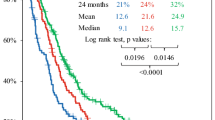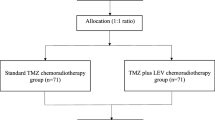Background and Purpose:
The role of radiochemotherapy in the treatment of primary glioblastoma multiforme is still discussed controversially. To evaluate the feasibility and toxicity of irradiation and concomitant administration of 50 mg/m2 temozolomide in patients with primary malignant glioma, this phase I/II study was conducted.
Patients and Methods:
53 Patients with histologically confirmed WHO grade IV malignant glioma were enrolled into the study. All patients were treated with radiation therapy up to a total dose of 60 Gy using conventional fractionation of 5 × 2.0 Gy/week. Temozolomide was administered orally each therapy day at a dose of 50 mg/m2.
Results:
Prior to radiochemotherapy, complete resection (n = 14), subtotal resection (n = 22) or a biopsy (n = 17) of the tumor was performed. The median time interval between surgery and radiochemotherapy was 21 days. Treatment-related toxicity was very mild. Acute toxicity > grade 2 was observed in one patient who developed grade 4 hemotoxicity. Minor side effects of chemotherapy included nausea and vomiting. No severe late effects were observed. Median progression-free and overall survival were 8 and 19 months, respectively. The overall survival rate was 72% at 1 and 26% at 2 years. Age and extent of surgery significantly influenced survival.
Conclusion:
The combination of temozolomide plus radiation therapy is feasible and safe in terms of toxicity. Overall survival times were relatively long compared to survival times reported for radiotherapy alone. The application of 50 mg/m2 of temozolomide can be performed throughout the whole time course without interruption due to side effects and might largely contribute to the prolonged overall survival. Further evaluation is warranted as to which dose of temozolomide is optimal with regard to tumor response and toxicity.
Hintergrund und Ziel:
Die Rolle der Radiochemotherapie in der Behandlung des primären Glioblastoma multiforme wird derzeit noch kontrovers diskutiert. Die vorliegende Studie evaluiert die Durchführbarkeit und Toxizität der Strahlentherapie mit simultaner Gabe von 50 mg/m2 Temozolomid zur Therapie von Patienten mit primärem Glioblastoma multiforme.
Patienten und Methodik:
53 Patienten mit histologisch gesichertem Glioblastoma multiforme (WHO-Grad IV) wurden in die Studie eingeschlossen. Alle Patienten wurden mit einer Strahlentherapie bis zu einer Gesamtdosis von 60 Gy in Einzeldosen von 2 Gy in konventioneller Fraktionierung fünfmal pro Woche behandelt. Temozolomid wurde an jedem Tag der Strahlentherapie in einer oralen Dosierung von 50 mg/m2 appliziert.
Ergebnisse:
Vor der Strahlentherapie wurde bei 14 Patienten eine komplette Tumorresektion, bei 22 Patienten eine partielle Resektion und bei 17 Patienten ein Biopsie durchgeführt. Das mediane Zeitintervall zwischen neurochirurgischer Resektion und Strahlentherapie betrug 21 Tage. Die Toxizität was sehr gering ausgeprägt. Eine Akuttoxizität > CTC Grad 2 fand sich nur bei einem Patienten als Grad-4-Hämatotoxizität. Übelkeit und Erbrechen traten als milde Nebenwirkungen auf. Schwere Spätnebenwirkungen wurden nicht beobachtet. Das mediane progressionsfreie Überleben und das Gesamtüberleben betrugen 8 und 19 Monate. Die Gesamtüberlebensrate nach 1 Jahr und nach 2 Jahren lag bei 72% und 26%. Das Alter und das Ausmaß der neurochirurgischen Resektion beeinflussten das Gesamtüberleben signifikant.
Schlussfolgerung:
Die Kombination von Temozolomid und Strahlentherapie erweist sich im Hinblick auf die Toxizität als durchführbar und sicher. Das Gesamtüberleben ist relativ lang, verglichen mit Überlebenszeiten, die für die Behandlung mit alleiniger Strahlentherapie in der Literatur zu finden sind. Die Applikation von 50 mg/m2 Temozolomid kann ohne Unterbrechung wegen Nebenwirkungen während der gesamten Dauer der Strahlentherapie durchgeführt werden. Damit könnte sie einen großen Einfluss auf das Gesamtüberleben haben. Weitere Studien zur Bestimmung der optimalen Dosis von Temozolomid vor dem Hintergrund der Nebenwirkungen und des Tumoransprechens sind notwendig.
Similar content being viewed by others
Author information
Authors and Affiliations
Corresponding author
Rights and permissions
About this article
Cite this article
Combs, S.E., Gutwein, S., Schulz-Ertner, D. et al. Temozolomide Combined with Irradiation as Postoperative Treatment of Primary Glioblastoma Multiforme. Strahlenther Onkol 181, 372–377 (2005). https://doi.org/10.1007/s00066-005-1359-x
Received:
Accepted:
Issue Date:
DOI: https://doi.org/10.1007/s00066-005-1359-x




